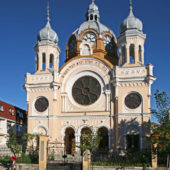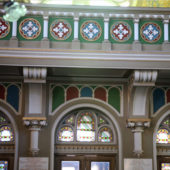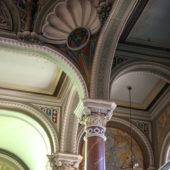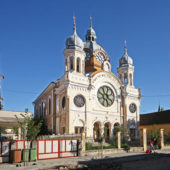This uniquely ornate and beautiful synagogue stands in a city where there is no longer a Jewish community.
Without a doubt one of the outstanding examples of early 20th Century synagogues in Romania, the Great Temple of Targu Mures is the product of Viennese Jewish architect, Iakob Gartner.
Built in 1899-1900, the Great Temple was the house of worship for the city’s thriving Jewish community that continued to grow right up to the beginning of the Second World War, with Jewish population exceeding 5,000 or more than 13% of the population. At the time of the synagogue’s construction, Targu Mures was part of the Austro-Hungarian Empire and would remain so until the end of World War I, when the region became part of Romania.
Gartner employed an eclectic mix of architectural styles and influences including Moorish, Romanesque, Gothic and Baroque are all in evidence both in the exterior and interior of the edifice. On the outside, the most striking features are the twin onion shaped domes towers and the main octagonal dome itself, each of its sides featuring a rosette window. A Star of David, or Mogen David, sits atop each dome. Above the three-arched porch that serves as the main entrance is the dominant rosette window, topped by a large Hebrew inscription.
The interior is a masterful blend of eclectic styles that Gartner successfully managed to harmonize into a unified whole. Ornate balustrades, Corinthian capitals atop marble columns and Moorish influenced floral patterns painted in reds, greens, blues and whites contribute to an atmosphere of near extravagance. The bimah is centrally located in the main hall and has a railing surrounding it with candelabras on each of its corners . The ark also is ornately decorated, framed by columns and topped with a rosette and other features that call to mind its baroque influences. The synagogue seats 552, with 238 places on the second level women’s balcony.
In World War II, the Nazis forced Targu Mures Jews into a ghetto and later deported them to Auschwitz, Bergen Belsen and Dachau concentration camps. Most perished in the camps or never returned to Targu Mures. A plaque honoring the victims is located in the main hall of the synagogue and there is a memorial sculpture in a nearby city square. A small population did return after the war but the synagogue slowly fell into disrepair. Fairly recent restoration work has returned the Temple to a much more respectable and attractive condition.





